Overnight, VR has spread all over the world. The VR-related conference was also a one-off event. Domestic and foreign giants focused on the VR market and announced their entry into the VR industry. But what exactly is VR? Let's explore this VR today.
I. Industry Overview
(1) VR definition
VR was first proposed in the 1960s. It is the abbreviation of Virtual Reality, which is literally interpreted as virtual reality. It refers to the creation of a new three-dimensional environment by means of computer systems and sensor technology, creating a new state of human-computer interaction, by mobilizing users. All senses (visual, auditory, tactile, smelling, etc.) bring a more authentic, immersive experience.
The core of VR is the creation of content, virtual reality, let people participate, create immersion, and achieve a feeling of entering other time and space. VR can be said to create a 100% real closed virtual platform, such as VR helmet, by cutting off your visual input into the real world path, bringing you into the virtual three-dimensional space created, creating the illusion of "complete presence."
(2) The difference between VR and AR
Literally speaking, AR (ARGMENTED REALITY) augmented reality is the application of virtual information to the real world through computer technology. Generally, through the projection device, the real and virtual environment and objects are superimposed on the same screen or space in real time. The main body here is people, and the core of technology combines reality and virtuality to achieve interaction. AR is more like a real-time interactive terminal for many applications, giving the real world superimposed virtual objects or electronic information, thus achieving an "enhanced" effect on reality.

The difference between VR and AR
(3) VR industry chain
With the continuous development of the VR industry and the fierce market, the VR industry chain has basically formed, covering hardware, systems, platforms, development tools, applications and consumer content.

VR industry chain
Second, the industry development process
From the 1950s to the present, virtual reality technology has experienced a period from the germination stage to the rapid development and improvement. With the rapid development of computer hardware and software technology, the advancement of new generation CPU, GPU, display technology and sensing technology has laid a solid technical foundation for the development of VR, and promoted VR widely used in all walks of life.
In 1957, filmmaker Morton Heiling invented a simulation simulator called Sensorama and patented the technology five years later. This device uses a three-sided display to achieve a sense of space. Essentially, Sensorama is just a simple 3D display tool. It is not only huge, but users need to sit in a chair and poke into the inside of the device to experience immersion.
In 1968, Ivan Sutherland, the father of computer graphics and a famous computer scientist, designed the first head-mounted display Sutherland. Although it is a head-mounted display, Sutherland is quite heavy due to hardware technical limitations at the time. It cannot be worn independently. It must be built on the ceiling, otherwise it will not work properly.
In the 1970s and 1980s, the whole virtual technology theory and concept were formed. The various components that make up the virtual helmet are technically mature and can be bought in the market.
In the 1990s, the theory of virtual technology was very mature, but the corresponding VR helmet was still a conceptual product. A VR product called "Virtuality 1000CS" appeared in 1991 was cumbersome, single-function, and expensive. However, the fire of VR games was also planted at this time, but it did not reach popularity.
Today's VR products are hot, Oculus, Google, Samsung, Sony and other companies insist on exploring business models, hardware products, content resources continue to increase.

VR industry development process
Third, the industry development environment analysis
Political environment: release policy dividends and help industry development
At the Third Session of the 12th National People's Congress in 2015, Premier Li Keqiang first proposed the “Internet Plus†action plan in the government work report to promote innovation and mass entrepreneurship. The reference to technological innovation was more diverse and created an atmosphere for the development of the VR industry. The transformation of “production, study and research†has become more smooth, the sources of researchers are more diverse and diversified, and the enthusiasm of entrepreneurship has been fully stimulated.
Economic environment: national consumption transformation, driving VR consumption
The income of Chinese residents has maintained rapid growth, prices have remained stable, residents' purchasing power has increased, and the proportion of enjoyment consumption has increased. After 85, consumers grew up with the development of the Internet, and their entertainment spending power was strong. The VR-related entertainment industry has a strong willingness to pay. In addition, the VR industry has become more and more widely publicized, the market is hot, and consumers are aware of VR devices. The level is getting higher and higher, which promotes VR consumption.
Technical environment: rapid development of software and hardware technology, boosting product innovation
One of the major obstacles to the development of VR is the user's motion sickness and immersion. Motion sickness is the feeling that a VR experiencer experiences dizziness in the experience. This is because the video image processing of virtual reality is used to approximate the real world, and the rendering requirements of the video image are more strict, so the requirements for chip computing power and image processing capability are higher, when all the information is videoized. When the method is presented and enlarged several times in front of the user, the data computing capability, the data transmission speed, and the screen refresh rate become an important bottleneck for the technical realization.
Constrained by processor chip, image processing technology, display system and sensing technology, the resolution and refresh rate of 3D stereo content are low, and the imaging delay phenomenon is more serious. Especially when adding motion capture to interact, the delay leads to immersion is not strong, even With motion sickness, people can't really feel the way into the virtual world. However, with the continuous advancement of chip technology, the GPU+CPU combination has begun to appear, the display technology has been continuously improved, and the rapid feedback technology of vision, sound and touch has been emerging and applied in VR. So that the current VR has basically used the general public, and can have a better all-round interactive experience for it. The technical foundation of VR products entering the general consumer has been built.
Fourth, the status quo of the industry
(1) China's VR potential users are huge
According to the China VR Behavior User Behavior Research Report, the potential users of VR in China have reached 286 million, and the number of VR users who have contacted or experienced virtual reality devices in the past year is about 17 million. There are about 960,000 users of VR virtual reality devices. The technology otaku has become the main force among VR users. Among the VR heavy users, males account for more than 70% of the total. According to the age characteristics, young people aged 25-34 account for more than 60%, and the VR severity of “home†is compared in life. Users are also high consumers of products such as technology and digital. Among the VR equipment types that VR heavy users plan to purchase in the next year, the number one is VR glasses, accounting for 83.1%. The main reason for purchasing VR glasses is to update their VR devices, followed by PC. The end VR helmet, which accounts for more than 1/3, is followed by a VR all-in-one. Due to its portable and convenient operation, VR glasses are becoming the mainstream equipment of VR. According to this market expectation, the market potential of China's VR industry will reach trillions.
(2) The market continues to heat up and a large influx of capital
With the addition of Internet, software, hardware, content production, platforms, and even film and television companies such as facebook, google, Apple, HTC, Samsung, Tencent, Microsoft, Stormwind, LeTV, Huayi Brothers, etc., virtual reality has become the most Popular areas.
International companies mainly involved in VR are: Qualcomm, Google, Sony, HP, Samsung and other companies. See the table below for details:

International companies involved in VR
Domestic companies mainly involved in VR are: Alibaba, Tencent, Shanda Group and so on. details as follows:
On March 17, 2016, Alibaba announced the establishment of a VR (Virtual Reality) laboratory. According to reports, Ali will take advantage of the platform to simultaneously promote VR content development and hardware incubation. In terms of content, Ali has fully launched the Buy+ program to lead the future shopping experience, and will cooperate with its film, music, video sites, etc. to promote high-quality VR content output. In terms of hardware, Ali will build the VR business ecosystem based on the world's largest e-commerce platform, accelerate the popularization of VR equipment, and help the development of hardware manufacturers.
Lei Jun invested 180 million yuan in the virtual reality company Shanghai Music (renamed Dapeng VR), focusing on the development of virtual reality head-mounted display products and the construction of virtual reality content platform, and has full-immersion virtual reality on PC and mobile. Wearing a product. It also has a 3D broadcast of content distribution platform, with more than 1.5 million users.
Shanda Group invested 1.25 million US dollars in the UploadVR startup team. Da Peng VR was established in April 2015, focusing on the development of virtual reality headset display products and the construction of virtual reality content platform, and has full-immersion virtual reality on PC and mobile. Wearing a product. It also has a 3D broadcast of content distribution platform, with more than 1.5 million users.
Tencent launched the Tencent VR SDK and developer support program, which first announced Tencent's own plans for VR. Based on the maturity of the market, it is expected to launch mobile VR and all-in-one solution for mobile phones in the third quarter of 17 years. In the other 15 years, the Zinna Boutique Travel Network received more than 80 million RMB A+ investment from Tencent, which is the first step for Tencent to participate in the VR+ tourism industry.
In October 2015, Huayi Brothers' subsidiary Huayi Brothers Interactive Entertainment acquired a portion of the shares of St. Witt, adding live entertainment. In recent years, Huayi has been laying out the entire industry chain, from IP to the final derivatives, including online games, theme parks and so on.
Tianyin Holdings, Ai Shide, Huayi Brothers and three A-share listed companies also announced that they have invested in the company's capital increase and share expansion plan, investing 24 million yuan, 15 million yuan and 9 million yuan respectively. Storm Technology is the major shareholder of Storm Mirror.
(3) The market financing amount exceeds 1 billion yuan, and the investment speed soars.
Driven by China's innovation-driven strategy, China's VR industry has attracted a large amount of capital injection, with investment ranging from one million to ten million, and the investment rate has soared. According to relevant statistics, in 2015, the total financing of 29 VR companies in China exceeded 1 billion yuan in the past year.
From the perspective of the industry, from 2015 to 2016, the display equipment industry accounted for the highest proportion of financing, up to 69%; followed by the software and input equipment industry, accounting for 6%. It can be seen that the industry is mainly oriented to display devices.

Distribution of domestic VR financing industry in 2015-2016
From the analysis of the number of financing cases, the number of display equipment industry cases accounted for 30% in 2015-2016, but the total financing amount was as high as 69%, showing that the hardware is hot; the amount of content production financing is large, but the amount is relatively small.

2015-2016 domestic VR financing case number industry distribution
Fourth, market capacity forecast
Although the VR industry is still in its infancy, the future market has great potential and attractive prospects. According to the famous research and analysis company Digi-Capital, the VR/AR hardware and software market potential will reach 150 billion US dollars, and the compound growth rate is expected to exceed 100% in the next 5 years. According to game industry analysis company Superdata, 70 million VR heads will be sold by the end of 2017, bringing 8.8 billion US dollars in virtual reality hardware profits and 6.1 billion dollars in virtual reality software. According to the latest forecast from TrendForce, the leading provider of market intelligence for the global electronics industry, the total market value of virtual reality in 2016 will be close to $6.7 billion. But by 2020, if Apple joins, its value may be as high as $70 billion.
Industry pain points still exist, will stimulate the rapid development of VR industry
First of all, components, hardware and other requirements are high, limiting the application of product upgrades. At present, the comfort of VR hardware products still does not meet the needs of consumers, and the experience needs to be improved. Research on the VR hardware devices that have been listed, the comfort is not good, consumers can not wear for a long time, the reason is because the equipment is heavy and easy to produce visual fatigue, or even motion sickness. These are urgently needed VR equipment manufacturers, as well as the accessories companies to pay attention to and step up to solve the problem. Improving the comfort, pleasure and safety of VR devices is the most direct springboard for users in the VR market. CPU+GPU combinations are beginning to emerge, display technologies such as AMOLEDs that reduce latency, and fast feedback techniques for vision, sound, and touch are emerging. These have played a major role in customer service dizziness and content interaction. The accelerated advancement of technology will drive the continuous development of the VR industry.
Second, the content is still scarce and the quality is difficult to guarantee. In the market, VR content is mainly based on promotional videos and games DEMO, mainly because of high content creation barriers, difficulty, and insufficient investment. However, at the same time, under the premise of technology giants, investment acceleration, and talent emergence, various types of VR content manufacturers will be able to expand horizontally and vertically in content, so that content can be diversified in form and type. VR content brand. Of course, as content continues to expand, it is necessary to strengthen supervision, set industry standards, protect intellectual property rights, resist cottages, and create super IP in the VR field.
Again, the usage scenario still has limitations to be developed. With the industry giants devote themselves to the production of VR applications, the game industry bears the brunt; animation and theme parks are also closely integrated with VR to achieve seamless docking; film and television, live broadcast under the support of VR shooting technology, gradually approaching . In addition, the tourism industry, the online education industry, the medical industry, and even the aerospace and military industries are constantly merging with VR. The VR usage scenario is constantly increasing and expanding. With the development of technology, more application scenarios will emerge in the future.
Finally, industry standards are missing and equipment is diverse. Due to the wide variety of devices, there are problems such as operating system and version splitting. These factors have also increased the difficulty of adapting games, movies, live broadcasts and other platforms. The killer applications and equipment in the market have not yet appeared. The VR industry is still at the forefront of development. The environment within the industry has not yet formed a stable state. This has prompted the industry to continuously cooperate, integrate and build industry standards. Build a smooth and harmonious ecological environment.
6'' Wheel Plate Caster series , as a professional Chinese caster manufacturer ,with rich R&D experience , which enable us to customize according to client's request , Size of top plate , wheel material , type of brake , just let me know what you want , Rich industrial caster series , various from rigid wheel caster , swivel caster and brake caster , full size series make us become one-stop caster services center for you .
6'' Wheel Plate Caster
6'' Wheel Plate Caster,Small Size Casters With Brake,Pvc Wheel Swivel Caster,Plate Tpe Wheel Caster
Zhejiang Lingda Caster Co., Ltd , https://www.ldcaster.com
